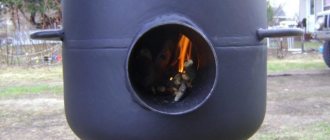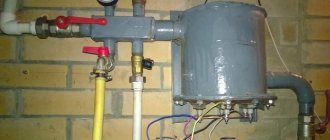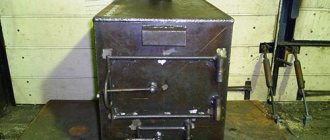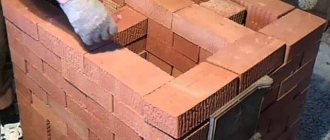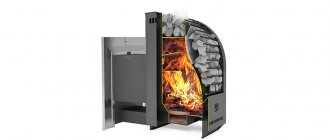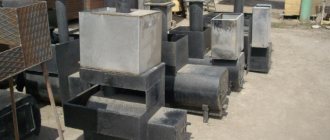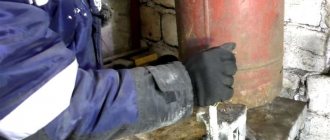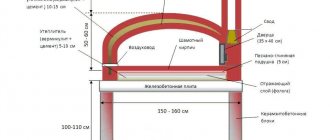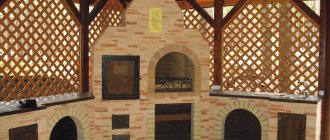Features and types of homemade stoves from a gas cylinder
All solid fuel stoves made from a gas cylinder have common design elements:
- A housing in which holes are cut for the door, vent and exhaust pipe.
- Blower.
- Exhaust pipe equipped with a throttle valve.
- A grate located low above the bottom of the stove. Fuel is placed on it and its combustion occurs.
- Internal walls that form the flow of combustion products.
- Legs.
Potbelly stove design
Through the door, fuel is loaded and ash and slag are removed from the grate space. An air flow enters the combustion chamber through the blower and the combustion mode is adjusted. The blower is made as a structural part of the door or is made in the form of a separate hole with a damper. A throttle-type damper is installed into the exhaust pipe, which also regulates the combustion mode. Gas cylinder stoves are available in vertical and horizontal versions. A horizontal oven is easier to implement, but takes up a lot of space. The vertical one can be placed in any corner of the room; it has significantly better draft and fuel combustion efficiency.
Vertical oven from a gas cylinder Horizontal oven from a gas cylinder
In liquid fuel furnaces (they are also called oil or drip furnaces), instead of a grate, a burner of one design or another is fixed and a fuel supply pipeline is installed. The door is much smaller - it is not needed for loading fuel and removing ash and slag, but only for adjusting the air flow, as well as for installing and servicing the burner.
To the basic configuration of a gas cylinder stove, a home craftsman can add various improvements: a burn-protection guard, burners for heating and preparing food and drinks, hangers for drying clothes and shoes, etc.
Gas fireplace installation
We will talk, first of all, about a gas fireplace using liquefied domestic gas, or propane-butane. This type of bottled fuel has become especially valuable for suburban buildings, where there is no electrical energy, much less network natural gas.
Of the gas fireplaces available to a simple dacha owner for a suburban area, there are 3 main designs:
- Burner and nozzle models - gas in cylinders burns in a simple burner, and the heated combustion products, flowing around the radiator, heat both the air and the body of the fireplace in the same way as happens in a gas household oven.
- Fireplaces based on flameless heating systems - the main device here is a powerful infrared burner, which is installed in the center of the fireplace insert.
- Fireplace stoves based on catalyst burners - in this case, the gas from the can after mixing with air does not begin to burn, but will oxidize on the catalyst mesh, releasing low-temperature heat.
For comparison, in a gas fireplace with an infrared burner, the hot surface will heat up to +1100 degrees, and in nozzle models the fire temperature ranges from +800...+850 degrees. A high level of air temperature leads to a decrease in humidity and a decrease in the oxygen content in the air, and therefore the organization of normal supply and exhaust ventilation in the room will be a prerequisite. Unlike diesel fuel, kerosene or any other hydrocarbon fuels, gas will provide the cleanest possible combustion. It is important that when a gas cylinder burns, no toxic combustion products appear, but salt or gasoline burners can easily cause poisoning from processed gas. The amount of unburned fuel and soot in a gas fireplace, depending on the model, can be much higher at 0.01% efficiency and can reach up to 95-98%.
How to choose a cylinder
A 5 liter household gas cylinder is too small to heat the room. And fuel can only fit in it in the form of briquettes or wood chips. A 12-liter cylinder will allow you to develop thermal power up to 3 kW. This stove can warm a small lodge or tent. Gas cylinders of 27 liters provide up to 7 kW, we can talk about heating a small garden house, greenhouse or garage.
Gas cylinder options
And finally, the king of household gas cylinders is the 50-liter giant. This is the best option for creating a potbelly stove with your own hands, suitable for heating a country house. 40-liter industrial gas cylinders have too small a diameter and thick walls. It is better to cut and shorten them. Thick walls will take longer to warm up and retain heat longer. Such a stove will also last significantly longer.
Selection and preparation of the cylinder
If we compare gas cylinders based on the volume/wall thickness/weight ratio, the best option is to make a stove from a 50-liter propane cylinder. Its height is 85 cm and its diameter is 30 cm. Thanks to the sufficient thickness of the metal, such a homemade stove will not burn out over several seasons of active use.
Choosing a cylinder for the stove
The manufacture of the furnace begins with the preparation of the cylinder. To eliminate the risk of gas residue exploding when cutting the cylinder, it should be properly prepared.
- unscrew the tank valve and leave overnight so that the gas evaporates;
- turn the cylinder upside down and drain the condensate into an unnecessary container;
- fill the container to the top with water;
- drain the water completely.
Read also: Holes for threads metric table GOST
Technology for making a stove from a conventional gas cylinder
IMPORTANT! Before starting work with any gas cylinder, it is necessary to completely remove any remaining gas from it! To do this, the cylinder is filled with water and detergent, designed to rid the future stove of gas odors and mercaptan fragrances.
Next, mark the holes for the door, vent and exhaust pipe and cut them out with a grinder. You can purchase a ready-made cast iron stove door in a block with a blower. In this case, a frame of their corners is welded to the opening in the gas cylinder, and a cast door is bolted to it. If aesthetics are not so important, then the door is made from a cut piece of a cylinder. In this case, a more or less wide gap will inevitably remain. In the most primitive version, there are no grates and protrusions that form the flow of combustion products.
The fuel is loaded onto the bottom of the stove, and after it is completely burned out, the ash is removed with a scoop. In this embodiment, it is difficult to implement a continuous combustion mode. Features of making a horizontal potbelly stove A horizontal stove made from a gas cylinder is quite suitable for heating a garage or greenhouse.
In a horizontal potbelly stove there is little space left to place the grate and ash tray, so sometimes the grate is welded into the bottom of the stove, and the ash box is welded from below. Potbelly stove doors are hung on purchased or homemade hinges. An interesting option is that hinges are three links of a massive drive chain from a powerful engine or other mechanism; the outer links are welded to the wall and to the door, respectively.
Manufacturing recommendations
A potbelly stove made from a cylinder can be different: the container can be placed horizontally or vertically. You need to choose the right size case and then use it correctly.
You will need sheet material made of steel that is resistant to prolonged heating, thick wire for the grate, an angle for the legs, etc. During the manufacturing process, a number of nuances should be taken into account to make the stove convenient and efficient.
Stage No. 1 - selection and preparation of the cylinder
Gas cylinders are very different. For a potbelly stove, a container for liquefied gas of 50 or 40 liters is best suited. If you need a small oven, you can take a cylinder with a volume of 12 or 27 liters.
But this will be a device for heating small utility rooms. Similar five-liter containers are practically useless. Such a small potbelly stove will heat up quickly, but will soon cool down, so the heating effect from it will be very insignificant.
An interesting option for a homemade potbelly stove is a freon container. Such a cylinder has thick walls and an elongated body. The container needs to be cut so that the length of the body is approximately 70 cm. Thick walls, of course, make the structure heavier, but retain heat better. The potbelly stove will take a long time to heat up, but at the same time it will heat up longer.
Before starting work, it is necessary to properly prepare the gas cylinder: bleed the remaining gas from it, drain the condensate and fill the container with water, which can then be poured out
When the cylinder is selected, you need to prepare the welding machine and remember the safety rules. Even in a very old cylinder there will always be some residual flammable gas. If you immediately start cutting it using welding, a life-threatening explosion is almost guaranteed. For those who have not yet used a welding machine, we recommend reading this article.
To begin with, it is recommended to open the cylinder and vent the remaining gas. Of course, this needs to be done outdoors, not indoors. Then you need to drain the remaining liquid that has condensed inside the cylinder. This substance usually has a strong and unpleasant odor, so it is best to prepare a small container with a lid for it in advance so that you can immediately carefully pack it and throw it away.
There are no particularly strict parameters requirements for the design of a potbelly stove. The larger the combustion chamber, the more spacious the room the unit can heat.
If condensation is accidentally spilled on the floor in a room, the specific aroma can persist for a very long time. After all these operations, the cylinder is still not ready for contact with the welding machine, because residual gas vapor remains inside.
You need to fill the balloon with water to the very top in order to completely displace all the gas from it. After this, the water is drained, now the cylinder can be cut without problems.
Stage No. 2 – manufacturing and filling the case
Next, you need to choose the type of potbelly stove from the cylinder, whether the cylindrical body will be located horizontally or vertically.
Image gallery
Photo from
Horizontally located stove body
Advantages of loading firewood into a horizontal cabinet
Minimum space for installing the stove
Portable potbelly stove from a mini cylinder
All other operations are carried out taking into account this orientation. If a horizontal position is selected, then one of the ends of the cylinder will serve as the rear wall, and on the other you need to install a loading door and a blower.
If you plan to make a vertical potbelly stove from a gas cylinder, you will need to make two holes: for loading fuel and for an ash pan with an ash pan.
For the grate, you can use thick reinforcing wire. In order not to cook a lattice out of it, you can bend it with a frequent zigzag, a “snake”. This structure is welded to the inner walls of the metal body.
The front wall is made of metal sheet as follows:
- The metal must be applied to the front of the stove to apply the markings.
- According to the markings, cut out a round part.
- Apply another marking on it: for the rectangular door and the blower.
- Cut holes according to the markings.
- Make doors.
- Weld hinges and latches to the front wall and hang the doors.
- Weld the wall with doors to the body.
Both doors along the contour should be sealed with asbestos-cement cord so that they fit well to the body. There is usually no need to create a back wall in such a potbelly stove; its role is played by the bottom of the cylinder. In the upper part of the body, close to the back wall, you need to make a hole for the chimney.
The pipe must be made of thick metal, since the lower part of the chimney will come into contact with heated smoky gases. Thin metal in this place will quickly burn out. Now strong legs made of reinforcement, pieces of metal or pieces of metal corner are welded to the bottom of the stove. They must withstand both the weight of the structure itself and the fuel that will be loaded into it.
Approximately the same technology is used to make a vertical potbelly stove from a cylinder. The bottom of the cylinder will become the lower part of the structure; at the top you need to make a cylindrical “roof” with a hole for the chimney. Usually the top of the balloon is cut off. Once installation is complete, you can weld it back. Doors - for loading and blowing - are made in the front part of the cylinder body.
Such a potbelly stove will take up less space than the horizontal version, and it will also be taller. If you intend to not only heat the room, but also cook food, then you will need to adjust the height of the stove taking this into account and ensure a flat cooking surface.
But usually the diameter of the cylinder is not large enough to provide a full cooking opportunity. Although boiling a kettle is a doable task.
This drawing allows you to get an idea of the design of a horizontal version of a potbelly stove made from a cylinder, to the bottom of which an ash box is attached
The grate can be made in the same way as described above: from fittings bent like a snake along the diameter of the pipe. It is welded between the loading and blower holes.
Some try to reduce the amount of welding work by leaving the top of the cylinder virtually untouched. But then all other work will be more difficult to complete.
In a horizontal potbelly stove, you can not weld the grate, but turn part of the body into it by drilling holes of a suitable diameter and attaching an ash box at the bottom
For example, the grate will have to be inserted not from above, but pushed into the fire door and somehow held in the correct position. Now you need to make doors with hinges and locks and weld them to the body of the potbelly stove, having previously sealed them with asbestos-cement cord. All that remains is to install the chimney pipe at the top and weld the legs at the bottom.
Stage No. 3 - manufacturing the door and ash pan
Doors for a potbelly stove can be made from those parts of the body that remain after cutting out the holes. Hinges and latches are welded to them. These are simple elements. Loops can even be made from thick chain links. The second, more expensive option is to purchase ready-made structures made of cast metal.
To install a ready-made cast door on a homemade potbelly stove, you should weld a frame made of a metal corner to the loading hole
You can choose two separate doors: a large one for the loading hole and a narrow one for the blower. But there are also kits in which such doors are combined into a single structure.
The holes for such doors must be cut exactly to size. After this, you need to weld a frame from the corner to the edges of the openings.
Several links of a thick chain, similar to a bicycle chain, can be used as hinges for a homemade potbelly stove door made from a cylinder
The frame of the cast doors is attached to the resulting frame using bolts. It is recommended to pre-weld a small side so that there are no gaps and the oven is closed hermetically.
In small potbelly stoves, you can, if desired, do without a grate altogether.
On the left is an inverted body of a horizontal potbelly stove with an ash pan welded to it, and on the right is a general view. The ash pan is pulled out to regulate the flow of oxygen; there is no need to make a blower in this model
Finding a place for it is difficult if the stove is made small or low, for example, a horizontal version. In such a device there is no vent; air access is provided using the loading door, which is simply opened slightly. Grate bars are easy to make from rebar, but they are not particularly reliable.
Over time, the fittings burn out and have to be replaced. An alternative would be a piece of sheet metal with circular slots or holes cut into it. To collect ash, you can use a special box - an ash pan.
In the horizontal version of a potbelly stove made from a cylinder, the grate can be installed in the lower part complete with an ash pan, since the lower part of the body will have to be cut off to facilitate installation.
Vertical oven assembly process
A vertical oven is more difficult to manufacture, but requires less space for its installation and has better user qualities. The volume of the cylinder is used more rationally. The principle of operation of the furnace does not change, but is implemented with greater efficiency. In the vertical version, two doors are made - for loading fuel and for the ash tray. Grate bars made of reinforcement are welded between these doors.
In principle, the entire upper part of the furnace can be dedicated to loading fuel, which will ensure long-term operation on one load. However, the volume of the combustion chamber is often reduced to accommodate additional heat exchangers in the upper part. One of the interesting options is through metal pipes welded into the upper part of the gas cylinder, through which air is driven by a fan (necessarily heat-resistant).
The process of assembling a vertical stove from a cylinder
Such a device will significantly increase heat transfer and reduce the heating time of the room several times. If forced water circulation is established through the passage pipes, a water heating system can be installed.
Creation options
Creating a vertical oven
Algorithm of actions:
- The cylinder is placed vertically and the neck is cut off.
- Using a marker, make marks on the surface. Mark the locations of the firebox, chimney, vent, etc.
Markings on a gas cylinder to create a vertical oven.
- Using a cutter or grinder, cut out the intended holes.
- Next, proceed to installing the grate. It is made from cut reinforcement. The parts are welded inside the body to the intended location in a snake or in a row.
- Door hinges are welded to the cylinder body and cast iron (metal) doors are installed. Latch bolts are attached to them or a sliding mechanism is constructed.
- If the potbelly stove will be used for cooking, then a metal sheet cut to size is welded to the top of the tank. This strip will be the hob.
- Seams and joints are cleaned and checked for strength and tightness.
- The opening for installing the chimney pipe is made on the side or at the top of the cylinder. The size of the opening must be equal to the diameter of the pipe. Often the smoke exhaust is made from above through the central hole in the cylinder. When installing on the side, the elbow is first welded to the cut-out opening, and then the pipeline itself is welded. It removes combustion products through the roof or wall of the room.
About
Long-burning stove bubafonya
A bubafonya-type stove made from a gas cylinder is a potbelly stove only in appearance. The design and principle of its operation are significantly different from a simple potbelly stove.
Scheme of operation of the bubafonya long-burning stove
Furnaces of this type are produced by several industrial enterprises, but they are not cheap. If you have an equipped home workshop and basic skills in welding and plumbing, a bubafonya stove from a gas cylinder is quite affordable to make with your own hands.
Preparatory work
Before you start building a furnace, you need to carefully plan all stages of the work. In particular, you need to prepare a gas cylinder and select a place to install the heating device. As for the technology, using the step-by-step instructions presented below you can avoid mistakes and carry out installation in the shortest possible time.
How to empty a cylinder of gas residues
You cannot start cutting a propane or methane cylinder without preparation, since even a small amount of gas, condensate or its vapor in combination with atmospheric oxygen is an explosive mixture. The slightest spark is enough for an explosion to occur. You can make the container completely safe using the method presented below.
- Open the valve and release the gas from the container.
- Using an adjustable wrench or a gas wrench, remove the tap.
- Turn the can over and drain the remaining gasoline.
- Place the container vertically and fill it with water through the top opening. In this case, all flammable components will be displaced by the liquid.
- After drying the cylinder in the open air, you can begin any plumbing work, including welding and burning old paint with a blowtorch.
Which location is suitable for installing the stove?
Even though we are looking at a mobile structure, most of the time it will be used to heat a garage, shed or workshop. To ensure that the operation of the heating device does not lead to unpleasant consequences, when choosing a location, they are guided by the current provisions of SNiP, sanitary and fire safety standards.
- The floor under the stove is constructed using non-combustible materials - fireclay bricks, cement-sand screed, asbestos fiber board or metal sheet.
- It is prohibited to install heating devices near storage areas for fuels, lubricants and other flammable materials and substances.
- When installing the stove, be sure to take into account the configuration of the chimney. The places where it passes through the roof must be protected with heat-insulating non-combustible materials.
- It is prohibited to install furnaces of this type under shelves, in places where attachments are close, etc.
- It is necessary to consider how the air flow into the room will be carried out. We should not forget that open-flame stoves consume a lot of oxygen.
- If the body of the heating device is located close to the flammable surfaces of the walls of the room, the latter are protected with heat-insulating shields.
When choosing a location for installing the stove, be sure to take into account the configuration of the chimney. Since most of the heat in direct combustion stoves is emitted into the chimney, they try to place it indoors, equipping it with a long horizontal or inclined section
It’s just important not to overdo it with its length and number of turns, since the traction force, and therefore the thermal power of the heating device, depends on this
Features and principle of operation
It implements the principle of long-term combustion, based on the physical and chemical phenomenon of pyrolysis - the smoldering of fuel with a lack of oxygen and the combustion of gases released during this process. One load of firewood is enough for 4-8 hours of burning. The design of the stove is different in that the air supply pipe with a damper at the end is located vertically and exits through the top of the stove with a small, non-sealed gap,
The pipe has vertical mobility. At its lower end there is a massive disk with guides for the flow of gases. The chimney is welded to the top of the stove on the side. Firewood is loaded into the oven vertically, the disk presses it against the grate. As the lower layers of fuel burn, the disk lowers and combustion air is supplied to the upper layer of fuel, which is subjected to pyrolysis.
Advantages and disadvantages
The advantages of the Bubafonya top combustion stove are as follows:
- High fuel efficiency. Heat does not escape into the chimney.
- Ease of manufacture and operation.
However, the design also has disadvantages:
- It is impossible to replenish the fuel supply in the stove before it is completely burned.
- It is impossible to interrupt the combustion process.
- When the sand draft decreases, it smokes.
- Not suitable for quickly warming up cold rooms.
Necessary materials for making a bubafonya stove
The necessary materials are the same gas cylinder, fittings for the grate, a 90-degree pipe, a metal pipe one and a half meters long and a heavy disk with a diameter slightly smaller than the internal diameter of the gas cylinder.
A self-made bubafonya stove made from a gas cylinder is suitable for heating a greenhouse or other uninhabited space.
Features of operation
During operation, it is important to remember the following: Firewood in layers must be of the same length, they should be loaded carefully and evenly, avoiding distortions
Diagram of a long-burning stove Bubafonya
For initial warming up and entering the pyrolysis mode, the stove requires an hour or more, and up to one fifth of the fuel is consumed.
It is also necessary to carefully monitor the position of the damper to prevent smoke from entering the room.
How to make a stove from scrap materials
To make the case, you can take any metal product that has a cylindrical shape:
- propane tank;
- receiver from a railway car;
- regular barrel with a volume of 100 or 200 liters;
- pipe with a diameter of 300-500 mm.
Bubafonya stove from a large barrel
Note. The Bubafonya stove, made with your own hands from a barrel, does not last too long due to the thin walls that quickly burn out. The problem is solved simply - the unusable barrel is replaced with a whole one. The operation will take literally 30 minutes, which is required to weld the chimney pipe.
The piston is welded from a steel pipe, the diameter of which depends on the size of the fuel chamber. For a diameter of 300 mm (like a cylinder), a pipe of 57 x 3 mm is sufficient. A two-hundred-liter barrel needs more air, so the diameter of the air duct increases to 76 x 3 mm. The cross-section of the chimney pipe is selected accordingly, in the first case it will be 10, in the second - 15 cm. A steel sheet 1 cm thick will do for the load; a strip of 40 x 4 or 50 x 4 mm will be used for the distributors.
Read also: Flexible drive for engraver
The most common design shown in the drawing is made from a gas cylinder in the following order:
- Unscrew the valve of the cylinder, fill it with water and cut off the cap with a grinder, focusing on the factory weld. Cut a hole in it with a diameter of 60 mm, and weld a shell made of steel strip along the contour for a tight fit to the end of the body.
- Cut holes for venting gases and cleaning the ash pan, as shown in the drawing. Make a grate from 18-22 mm reinforcement and place it on two corners welded at the bottom of the firebox, as shown in the photo.
- Install a door or cleanout hatch and weld the smoke pipe.
- Cut a disk out of thick metal, make a hole in the center and attach the pipe by welding. The diffusers are made from bent strips, welding them to the back side of the load. To regulate the flow, install an eccentric valve at the second end of the pipe. That's it, the stove parts are ready.
Advice. It is very important to make distributors from bent strip. Their arrangement promotes fan-like dispersion of air in the firebox and uniform burning of wood.
Installation of Bubafoni and its connection to the chimney is carried out according to the standard scheme, as seen above in the picture. If you did not make grates and an ash pit door, then it is better to place the body on fireclay bricks so that the concrete in the garage does not crack due to heat. The lifting height of the chimney pipe is at least 4 m, and preferably 5 m. To get more visual information about the design and operation of the stove, we suggest watching the video:
Furnace in production
A waste oil furnace operates as follows: a supply of oil is poured into the fuel compartment, it is ignited, and more or less air flow is supplied through the air damper, thus controlling the power of the furnace. Combustion products rise through a vertical perforated pipe and carry with them vapors of evaporating oil.
This mixture is burned along the entire length of the pipe and enters the afterburner chamber, divided into two parts. In the first, oil vapors are burned, in the second, with a lack of oxygen, nitrogen compounds are split into oxygen and nitrogen. The resulting oxygen promotes afterburning of combustion products, ensuring constant temperature and energy efficiency.
Pyrolysis oil furnace
A pyrolysis oil furnace made from a gas cylinder has a very high efficiency - about 80%. The disadvantage of such a pyrolysis device is harmful fumes and an unpleasant odor. This stove is not suitable for residential premises or areas where animals are kept.
Tips and tricks
Experienced craftsmen advise making a potbelly stove from a gas cylinder, taking into account the following nuances:
The chimney should not take the shortest route. In this case, the heat will leave along with the combustion products. The optimal type of chimney is a broken pipe.
The chimney is made in a broken shape so that heat does not escape from the stove along with the smoke. Curved pipe prevents heat energy from escaping
It’s just important that the pipe is not made of aluminum!
- Any type of fuel can be used as fuel - coal, wood. If necessary, you can burn household waste and carpentry waste in a potbelly stove.
- You can increase heat transfer and make a potbelly stove with high efficiency by increasing the length of the chimney. Parts with straight sections or downward slopes should be avoided.
- If you attach an additional one to the main body cylinder (in the form of a vertical pipe), then you can use the heat twice as much. Such a potbelly stove of two cylinders creates good draft; combustion products and smoke will not enter the room/garage/utility room. In addition, the heat transfer of the heating device will increase.
Video: demonstration of a potbelly stove made from a gas cylinder
- To prevent a potbelly stove made from a gas cylinder from cooling down quickly, a mesh is welded to the chimney pipe and round river stones are placed there. The installation will work on the principle of a sauna stove. The stones distribute heat evenly and do not cool down for a long time. However, with such a potbelly stove, it will not be possible to quickly heat the room.
- A potbelly stove with a water jacket is another way to increase the efficiency of the stove. An expansion tank is welded around the cylinder and connected to the radiators. The volume of the tank should be 10% of the total displacement.
A potbelly stove made from a gas cylinder can be used both indoors and outdoors. On a horizontal installation with a hob, you can cook food and heat the kettle.
A potbelly stove made from a gas cylinder is a budget option for an efficient heating device that anyone can make. To do this, you need to have materials and tools on hand, as well as have basic skills in working with welding and a grinder.
How to make an oil stove from a cylinder
The gas cylinder exhaust furnace is made in a vertical design. The top part of the cylinder is cut off, into which the afterburner chamber is welded. There is a hole in the floor of the chamber that can be closed with a flap for adding oil. The outlet for the chimney from the afterburning compartment should be located as far as possible from its partition, at least 20 cm.
Oil stove for greenhouse
It is important to remember that oil should be added extremely carefully to a hot pyrolysis oven from a gas cylinder; it is better to wait for it to cool completely. In more complex designs, the oil pipe is removed through the top cover; oil can be added to such a stove without interrupting combustion. Making such a stove from a 50-liter cylinder is quite affordable for an average skilled craftsman
How to properly make a chimney
To ensure maximum stability in the operation of a stove structure made from a cylinder, it is imperative to arrange high-quality draft.
To achieve this goal, the cut of the stove chimney pipe must be installed at a certain height. This is slightly higher than the edge of the mounted grate. When connecting a gas chimney to the side, it is necessary to ensure that the length of the strictly horizontal section is approximately 400 mm. At the very bottom of the vertically located part, it is worth organizing high-quality removal of accumulated moisture, as the drawings show.
- At the same time, it is recommended to use certain measures regarding the removal of incoming heat from the chimney part. There are two methods for carrying out this process:
- A horizontal section is being installed at a slight inclination of 35 degrees. Immediately after this, the channel turns upward and leads out. A completed or purchased heat exchanger of a special samovar category is installed on the chimney element; The pipe, which leaves the furnace at a special angle and then passes through the rooms, will be able to transfer warm air. Thanks to this, overall efficiency indicators become higher, while at the same time fuel consumption is seriously reduced.
A heating system based on water fuel will provide the opportunity to install about 2 or 3 radiators in a country house or garage and provide them with heat. Such a device is characterized by simplicity in the manufacturing process, that is, a special water jacket is made in the chimney section, which has two high-quality pipes.
The circulation process present in the water circuit, which is mounted on the body of the stove chimney from a cylinder, will have to be adjusted in a forced manner. A household circulation pump is ideal for this purpose.
Types of oil furnaces
Using waste oil, you can make the already discussed pyrolysis furnace. Another type of oil stove made from a gas cylinder is a dripper or long-burning stove. There is a brick at the bottom of the combustion chamber. Above it there is a tube supplying oil (or diesel fuel).
Using a valve with a poppet valve, the oil supply is adjusted so that approximately one drop drips per minute. To start the furnace, a small puddle of oil is poured onto the brick and set on fire, the brick becomes hot, and the next drops burst into flames upon contact with it. Combustion products rise to the top of the stove and heat it.
Oven operation
Before igniting the Bubafoni, it is necessary to remove the welded air duct from inside the housing, first removing the top cap. Wood logs are placed inside the stove in a horizontal position, close to each other. When stacking vertically, some obstacles may arise in the path of the piston movement: this usually happens in cases where the logs are not completely burned. As a result, smoldering in the primary chamber will develop into full-fledged combustion, which seriously impairs the proper functioning of the stove. In this case, firewood is consumed much faster, and smoke begins to seep out of the air duct. When laying logs, it is prohibited to block the area where the chimney is welded.
A layer of chips, sawdust or chopped branches is poured onto the firewood. On top of them you need to put old cloth or paper soaked in kerosene. A piston is installed end-to-end on the fuel filler and a cap is put on. To light firewood, you need to light a piece of rags or paper and throw it inside through the air pipe. Matches are ineffective in this case, since they go out before they can reach the fuel. After lighting the firewood, pause for 15-20 minutes, allowing it to flare up well. When the flame gains strength, the valve on the air pipe should be closed: thus, Bubafonya is transferred to the main operating mode.
